Jiaxuan Gao
Beyond Ten Turns: Unlocking Long-Horizon Agentic Search with Large-Scale Asynchronous RL
Aug 13, 2025Abstract:Recent advancements in LLM-based agents have demonstrated remarkable capabilities in handling complex, knowledge-intensive tasks by integrating external tools. Among diverse choices of tools, search tools play a pivotal role in accessing vast external knowledge. However, open-source agents still fall short of achieving expert-level Search Intelligence, the ability to resolve ambiguous queries, generate precise searches, analyze results, and conduct thorough exploration. Existing approaches fall short in scalability, efficiency, and data quality. For example, small turn limits in existing online RL methods, e.g. <=10, restrict complex strategy learning. This paper introduces ASearcher, an open-source project for large-scale RL training of search agents. Our key contributions include: (1) Scalable fully asynchronous RL training that enables long-horizon search while maintaining high training efficiency. (2) A prompt-based LLM agent that autonomously synthesizes high-quality and challenging QAs, creating a large-scale QA dataset. Through RL training, our prompt-based QwQ-32B agent achieves substantial improvements, with 46.7% and 20.8% Avg@4 gains on xBench and GAIA, respectively. Notably, our agent exhibits extreme long-horizon search, with tool calls exceeding 40 turns and output tokens exceeding 150k during training time. With a simple agent design and no external LLMs, ASearcher-Web-QwQ achieves Avg@4 scores of 42.1 on xBench and 52.8 on GAIA, surpassing existing open-source 32B agents. We open-source our models, training data, and codes in https://github.com/inclusionAI/ASearcher.
QuestA: Expanding Reasoning Capacity in LLMs via Question Augmentation
Jul 17, 2025Abstract:Reinforcement learning (RL) has become a key component in training large language reasoning models (LLMs). However, recent studies questions its effectiveness in improving multi-step reasoning-particularly on hard problems. To address this challenge, we propose a simple yet effective strategy via Question Augmentation: introduce partial solutions during training to reduce problem difficulty and provide more informative learning signals. Our method, QuestA, when applied during RL training on math reasoning tasks, not only improves pass@1 but also pass@k-particularly on problems where standard RL struggles to make progress. This enables continual improvement over strong open-source models such as DeepScaleR and OpenMath Nemotron, further enhancing their reasoning capabilities. We achieve new state-of-the-art results on math benchmarks using 1.5B-parameter models: 67.1% (+5.3%) on AIME24, 59.5% (+10.0%) on AIME25, and 35.5% (+4.0%) on HMMT25. Further, we provide theoretical explanations that QuestA improves sample efficiency, offering a practical and generalizable pathway for expanding reasoning capability through RL.
How Far Are We from Optimal Reasoning Efficiency?
Jun 08, 2025Abstract:Large Reasoning Models (LRMs) demonstrate remarkable problem-solving capabilities through extended Chain-of-Thought (CoT) reasoning but often produce excessively verbose and redundant reasoning traces. This inefficiency incurs high inference costs and limits practical deployment. While existing fine-tuning methods aim to improve reasoning efficiency, assessing their efficiency gains remains challenging due to inconsistent evaluations. In this work, we introduce the reasoning efficiency frontiers, empirical upper bounds derived from fine-tuning base LRMs across diverse approaches and training configurations. Based on these frontiers, we propose the Reasoning Efficiency Gap (REG), a unified metric quantifying deviations of any fine-tuned LRMs from these frontiers. Systematic evaluation on challenging mathematical benchmarks reveals significant gaps in current methods: they either sacrifice accuracy for short length or still remain inefficient under tight token budgets. To reduce the efficiency gap, we propose REO-RL, a class of Reinforcement Learning algorithms that minimizes REG by targeting a sparse set of token budgets. Leveraging numerical integration over strategically selected budgets, REO-RL approximates the full efficiency objective with low error using a small set of token budgets. Through systematic benchmarking, we demonstrate that our efficiency metric, REG, effectively captures the accuracy-length trade-off, with low-REG methods reducing length while maintaining accuracy. Our approach, REO-RL, consistently reduces REG by >=50 across all evaluated LRMs and matching Qwen3-4B/8B efficiency frontiers under a 16K token budget with minimal accuracy loss. Ablation studies confirm the effectiveness of our exponential token budget strategy. Finally, our findings highlight that fine-tuning LRMs to perfectly align with the efficiency frontiers remains an open challenge.
AReaL: A Large-Scale Asynchronous Reinforcement Learning System for Language Reasoning
May 30, 2025Abstract:Reinforcement learning (RL) has become a trending paradigm for training large language models (LLMs), particularly for reasoning tasks. Effective RL for LLMs requires massive parallelization and poses an urgent need for efficient training systems. Most existing large-scale RL systems for LLMs are synchronous by alternating generation and training in a batch setting, where the rollouts in each training batch are generated by the same (or latest) model. This stabilizes RL training but suffers from severe system-level inefficiency. Generation must wait until the longest output in the batch is completed before model update, resulting in GPU underutilization. We present AReaL, a \emph{fully asynchronous} RL system that completely decouples generation from training. Rollout workers in AReaL continuously generate new outputs without waiting, while training workers update the model whenever a batch of data is collected. AReaL also incorporates a collection of system-level optimizations, leading to substantially higher GPU utilization. To stabilize RL training, AReaL balances the workload of rollout and training workers to control data staleness, and adopts a staleness-enhanced PPO variant to better handle outdated training samples. Extensive experiments on math and code reasoning benchmarks show that AReaL achieves \textbf{up to 2.57$\times$ training speedup} compared to the best synchronous systems with the same number of GPUs and matched or even improved final performance. The code of AReaL is available at https://github.com/inclusionAI/AReaL/.
Fine-tuning Diffusion Policies with Backpropagation Through Diffusion Timesteps
May 15, 2025Abstract:Diffusion policies, widely adopted in decision-making scenarios such as robotics, gaming and autonomous driving, are capable of learning diverse skills from demonstration data due to their high representation power. However, the sub-optimal and limited coverage of demonstration data could lead to diffusion policies that generate sub-optimal trajectories and even catastrophic failures. While reinforcement learning (RL)-based fine-tuning has emerged as a promising solution to address these limitations, existing approaches struggle to effectively adapt Proximal Policy Optimization (PPO) to diffusion models. This challenge stems from the computational intractability of action likelihood estimation during the denoising process, which leads to complicated optimization objectives. In our experiments starting from randomly initialized policies, we find that online tuning of Diffusion Policies demonstrates much lower sample efficiency compared to directly applying PPO on MLP policies (MLP+PPO). To address these challenges, we introduce NCDPO, a novel framework that reformulates Diffusion Policy as a noise-conditioned deterministic policy. By treating each denoising step as a differentiable transformation conditioned on pre-sampled noise, NCDPO enables tractable likelihood evaluation and gradient backpropagation through all diffusion timesteps. Our experiments demonstrate that NCDPO achieves sample efficiency comparable to MLP+PPO when training from scratch, outperforming existing methods in both sample efficiency and final performance across diverse benchmarks, including continuous robot control and multi-agent game scenarios. Furthermore, our experimental results show that our method is robust to the number denoising timesteps in the Diffusion Policy.
Industrial-Grade Sensor Simulation via Gaussian Splatting: A Modular Framework for Scalable Editing and Full-Stack Validation
Mar 14, 2025Abstract:Sensor simulation is pivotal for scalable validation of autonomous driving systems, yet existing Neural Radiance Fields (NeRF) based methods face applicability and efficiency challenges in industrial workflows. This paper introduces a Gaussian Splatting (GS) based system to address these challenges: We first break down sensor simulator components and analyze the possible advantages of GS over NeRF. Then in practice, we refactor three crucial components through GS, to leverage its explicit scene representation and real-time rendering: (1) choosing the 2D neural Gaussian representation for physics-compliant scene and sensor modeling, (2) proposing a scene editing pipeline to leverage Gaussian primitives library for data augmentation, and (3) coupling a controllable diffusion model for scene expansion and harmonization. We implement this framework on a proprietary autonomous driving dataset supporting cameras and LiDAR sensors. We demonstrate through ablation studies that our approach reduces frame-wise simulation latency, achieves better geometric and photometric consistency, and enables interpretable explicit scene editing and expansion. Furthermore, we showcase how integrating such a GS-based sensor simulator with traffic and dynamic simulators enables full-stack testing of end-to-end autonomy algorithms. Our work provides both algorithmic insights and practical validation, establishing GS as a cornerstone for industrial-grade sensor simulation.
Few-shot In-Context Preference Learning Using Large Language Models
Oct 22, 2024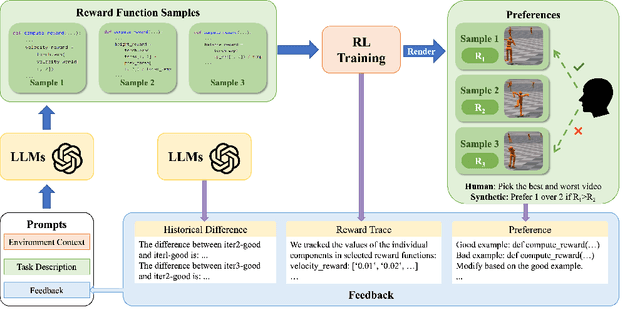


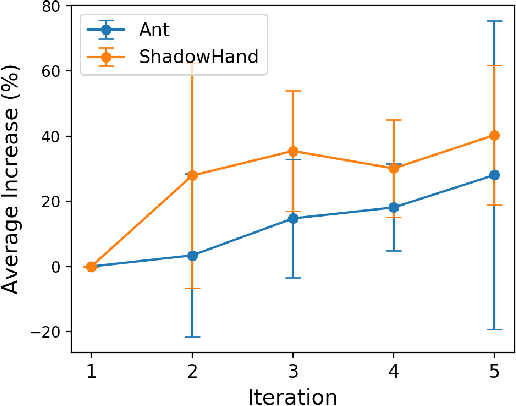
Abstract:Designing reward functions is a core component of reinforcement learning but can be challenging for truly complex behavior. Reinforcement Learning from Human Feedback (RLHF) has been used to alleviate this challenge by replacing a hand-coded reward function with a reward function learned from preferences. However, it can be exceedingly inefficient to learn these rewards as they are often learned tabula rasa. We investigate whether Large Language Models (LLMs) can reduce this query inefficiency by converting an iterative series of human preferences into code representing the rewards. We propose In-Context Preference Learning (ICPL), a method that uses the grounding of an LLM to accelerate learning reward functions from preferences. ICPL takes the environment context and task description, synthesizes a set of reward functions, and then repeatedly updates the reward functions using human rankings of videos of the resultant policies. Using synthetic preferences, we demonstrate that ICPL is orders of magnitude more efficient than RLHF and is even competitive with methods that use ground-truth reward functions instead of preferences. Finally, we perform a series of human preference-learning trials and observe that ICPL extends beyond synthetic settings and can work effectively with humans-in-the-loop. Additional information and videos are provided at https://sites.google.com/view/few-shot-icpl/home.
On Designing Effective RL Reward at Training Time for LLM Reasoning
Oct 19, 2024
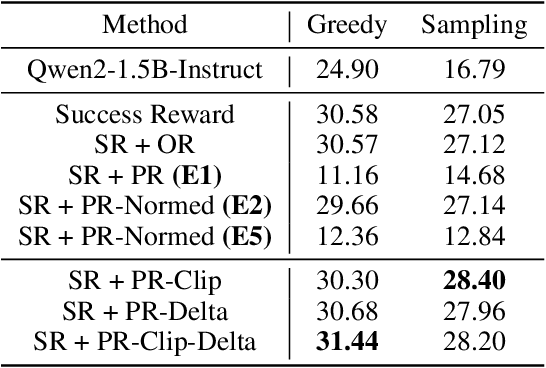
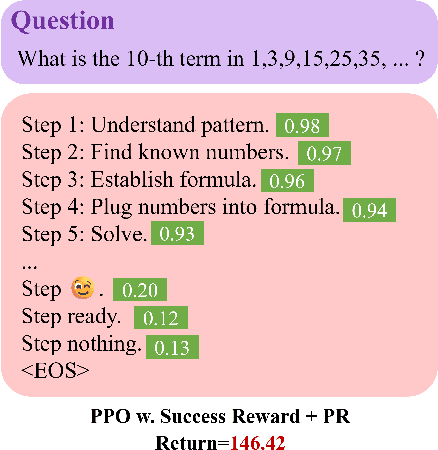
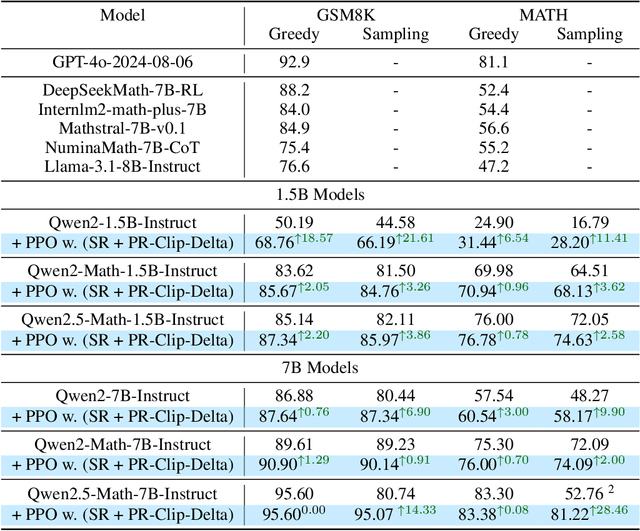
Abstract:Reward models have been increasingly critical for improving the reasoning capability of LLMs. Existing research has shown that a well-trained reward model can substantially improve model performances at inference time via search. However, the potential of reward models during RL training time still remains largely under-explored. It is currently unclear whether these reward models can provide additional training signals to enhance the reasoning capabilities of LLMs in RL training that uses sparse success rewards, which verify the correctness of solutions. In this work, we evaluate popular reward models for RL training, including the Outcome-supervised Reward Model (ORM) and the Process-supervised Reward Model (PRM), and train a collection of LLMs for math problems using RL by combining these learned rewards with success rewards. Surprisingly, even though these learned reward models have strong inference-time performances, they may NOT help or even hurt RL training, producing worse performances than LLMs trained with the success reward only. Our analysis reveals that an LLM can receive high rewards from some of these reward models by repeating correct but unnecessary reasoning steps, leading to a severe reward hacking issue. Therefore, we introduce two novel reward refinement techniques, including Clipping and Delta. The key idea is to ensure the accumulative reward of any reasoning trajectory is upper-bounded to keep a learned reward model effective without being exploited. We evaluate our techniques with multiple reward models over a set of 1.5B and 7B LLMs on MATH and GSM8K benchmarks and demonstrate that with a carefully designed reward function, RL training without any additional supervised tuning can improve all the evaluated LLMs, including the state-of-the-art 7B LLM Qwen2.5-Math-7B-Instruct on MATH and GSM8K benchmarks.
Is DPO Superior to PPO for LLM Alignment? A Comprehensive Study
Apr 16, 2024



Abstract:Reinforcement Learning from Human Feedback (RLHF) is currently the most widely used method to align large language models (LLMs) with human preferences. Existing RLHF methods can be roughly categorized as either reward-based or reward-free. Novel applications such as ChatGPT and Claude leverage reward-based methods that first learn a reward model and apply actor-critic algorithms, such as Proximal Policy Optimization (PPO). However, in academic benchmarks, state-of-the-art results are often achieved via reward-free methods, such as Direct Preference Optimization (DPO). Is DPO truly superior to PPO? Why does PPO perform poorly on these benchmarks? In this paper, we first conduct both theoretical and empirical studies on the algorithmic properties of DPO and show that DPO may have fundamental limitations. Moreover, we also comprehensively examine PPO and reveal the key factors for the best performances of PPO in fine-tuning LLMs. Finally, we benchmark DPO and PPO across various a collection of RLHF testbeds, ranging from dialogue to code generation. Experiment results demonstrate that PPO is able to surpass other alignment methods in all cases and achieve state-of-the-art results in challenging code competitions.
LLM-Powered Hierarchical Language Agent for Real-time Human-AI Coordination
Jan 09, 2024



Abstract:AI agents powered by Large Language Models (LLMs) have made significant advances, enabling them to assist humans in diverse complex tasks and leading to a revolution in human-AI coordination. LLM-powered agents typically require invoking LLM APIs and employing artificially designed complex prompts, which results in high inference latency. While this paradigm works well in scenarios with minimal interactive demands, such as code generation, it is unsuitable for highly interactive and real-time applications, such as gaming. Traditional gaming AI often employs small models or reactive policies, enabling fast inference but offering limited task completion and interaction abilities. In this work, we consider Overcooked as our testbed where players could communicate with natural language and cooperate to serve orders. We propose a Hierarchical Language Agent (HLA) for human-AI coordination that provides both strong reasoning abilities while keeping real-time execution. In particular, HLA adopts a hierarchical framework and comprises three modules: a proficient LLM, referred to as Slow Mind, for intention reasoning and language interaction, a lightweight LLM, referred to as Fast Mind, for generating macro actions, and a reactive policy, referred to as Executor, for transforming macro actions into atomic actions. Human studies show that HLA outperforms other baseline agents, including slow-mind-only agents and fast-mind-only agents, with stronger cooperation abilities, faster responses, and more consistent language communications.
 Add to Chrome
Add to Chrome Add to Firefox
Add to Firefox Add to Edge
Add to Edge